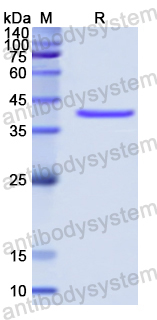Catalog No.
YHH27601
Expression system
E. coli
Species
Homo sapiens (Human)
Protein length
Val3-Leu132
Predicted molecular weight
41.80 kDa
Nature
Recombinant
Endotoxin level
Please contact with the lab for this information.
Purity
>90% as determined by SDS-PAGE.
Accession
Q16526
Applications
ELISA, Immunogen, SDS-PAGE, WB, Bioactivity testing in progress
Form
Lyophilized
Storage buffer
Lyophilized from a solution in PBS pH 7.4, 0.02% NLS, 1mM EDTA, 4% Trehalose, 1% Mannitol.
Reconstitution
Reconstitute in sterile water for a stock solution. A copy of datasheet will be provided with the products, please refer to it for details.
Shipping
In general, proteins are provided as lyophilized powder/frozen liquid. They are shipped out with dry ice/blue ice unless customers require otherwise.
Stability and Storage
Use a manual defrost freezer and avoid repeated freeze thaw cycles. Store at 2 to 8°C for frequent use. Store at -20 to -80°C for twelve months from the date of receipt.
Alternative Names
Cryptochrome-1, CRY1, PHLL1
Unravelling the link between circadian clock genes and brain tumors: From pathological disruptions to potential therapeutic interventions., PMID:40495887
Infrared-A (IR-A) modulates the p53 pathway and diurnal clock in human skin and subcutaneous adipose tissue in vivo., PMID:40482318
M54 selectively stabilizes the circadian clock component of CRY1 and enhances the period of circadian rhythm at cellular level., PMID:40480635
Optimization of main components of artificial compound feed (ACF) for Hippocampus kuda based on the synergistic expression of biological clock genes., PMID:40448724
The role of mitochondrial dysfunction in the pathogenesis of atherosclerosis: A new exploration from bioinformatics analysis., PMID:40441253
From clock genes to fitness: Molecular and behavioral rhythms, parental behavior, and reproductive success across a light pollution gradient., PMID:40436097
The burning glass effect of water droplets triggers a high light-induced calcium response in the chloroplast stroma., PMID:40398414
Synergistic Insecticidal Activity Against Hyphantria cunea by Cry9Aa3 Mutants and Cry1Ah Combinations., PMID:40331960
Nutritional profile of the diet according to circadian clock genes in the European Prospective Investigation into Cancer and Nutrition (EPIC) chronodiet study., PMID:40328174
Exploring differences in signaling pathways of the circadian clock and neuromodulators in obstructive sleep apnea., PMID:40287460
Full-Length Cryptochrome 1 in the Outer Segments of the Retinal Blue Cone Photoreceptors in Humans and Great Apes Suggests a Role Beyond Transcriptional Repression., PMID:40277221
Temporal mineralocorticoid receptor activation regulates the molecular clock and transcription of cardiovascular disease modulators in myeloid cells., PMID:40272082
The resistance of Solanum lycopersicum photosynthetic apparatus to high-intensity blue light is determined mainly by the cryptochrome 1 content., PMID:40270912
Two pathways mediate toxicity of Cry1Ac in Mythimna separata: one is ABCC2-dependent and the other involves ABCC3-CAD interaction., PMID:40268035
CRY1-GAIP1 complex mediates blue light to hinder the repression of PIF5 on AGL5 to promote carotenoid biosynthesis in mango fruit., PMID:40263966
Cry2 Alleviates Cisplatin-Induced Cytotoxicity in Mouse Renal Cortex Tubular Cell Lines., PMID:40254427
Quantitative measures of clock protein dynamics in the mouse suprachiasmatic nucleus extends the circadian time-keeping model., PMID:40247113
Intermittent theta burst stimulation regulates microglial polarization through Cry1 to enhance neuroplasticity for stroke recovery., PMID:40221010
Core Molecular Clock Factors Regulate Osteosarcoma Stem Cell Survival and Behavior via CSC/EMT Pathways and Lipid Droplet Biogenesis., PMID:40214471
Aminooxyacetic acid up-regulates the Cry1 and Bmal1 clock gene in a sirtuin 1 dependent manner. In vitro study., PMID:40210100
Rhythmic TDP-43 affects RNA splicing of USP13, resulting in alteration of BMAL1 ubiquitination., PMID:40202498
DNA methylation of core clock genes in patients with major depressive disorder: Association with air pollution exposure and disease severity., PMID:40184933
Assessment of continuous positive airway pressure effect on the circadian clock signaling pathway in obstructive sleep apnea patients., PMID:40175421
Blue light-emitting diode promotes mineralization of stem cells from the apical papilla via cryptochrome 1/Wnt/β-catenin signaling., PMID:40167571
A preliminary study on the regulation and impact of unfolded protein response on circadian genes in Litopenaeus vannamei., PMID:40154934
A CRY1-HY5-MYB signaling cascade fine-tunes guard cell reactive oxygen species levels and triggers stomatal opening., PMID:40139914
Interaction between 3-SNP genetic risk score and dietary fats intake on inflammatory markers among overweight and obese women., PMID:40093786
Cryptochrome 1 promotes photomorphogenesis in Arabidopsis by displacing substrates from the COP1 ubiquitin ligase., PMID:40052249
Transcription of Clock Genes in Medulloblastoma., PMID:40002179
Hypothyroidism impairs the circadian rhythmicity of clock genes and proteins involved in gut nutrient absorption in female mice., PMID:39958687
Study on the Mechanisms of Ischemic Stroke Impacting Sleep Homeostasis and Circadian Rhythms in Rats., PMID:39957482
Melatonin modulated GPX5 and PTGDS expression in Bactrian camel epididymis mainly via receptor MT1†., PMID:39951496
Elucidating the Interplay of Hypoxia-Inducible Factor and Circadian Clock Signaling in Obstructive Sleep Apnea Patients., PMID:39940739
Identifying CSNK1E as a therapeutic target in thyroid cancer among the core circadian clock genes., PMID:39904793
The impact of circadian rhythm disruption on oxaliplatin tolerability and pharmacokinetics in Cry1-/-Cry2-/- mice under constant darkness., PMID:39903276
Sex-dependent association of central circadian clock gene polymorphisms with clinical risk markers for noncommunicable diseases in the young population., PMID:39894351
Investigating the circadian rhythm signaling pathway in HTLV-1 pathogenesis using Boolean analysis., PMID:39892646
Regulation of circadian gene activity in fibroblasts from ADHD patients through Rosiglitazone: a pilot study., PMID:39884973
The CRY1-COP1-HY5 axis mediates blue-light regulation of Arabidopsis thermotolerance., PMID:39881540
Evaluation of the Digital Ventilated Cage® system for circadian phenotyping., PMID:39880968
Bioactive Potential of Some Bacillus thuringiensis Strains from Macapá, Amazon, Brazil, Against the Housefly Musca domestica (Diptera: Muscidae) Under Laboratory Conditions., PMID:39859608
Development of compounds for targeted degradation of mammalian cryptochrome proteins., PMID:39842482
Chronic CRYPTOCHROME deficiency enhances cell-intrinsic antiviral defences., PMID:39842480
Interplay of Light, Melatonin, and Circadian Genes in Skin Pigmentation Regulation., PMID:39825699
In Vivo Nitrosative Stress-Induced Expression of a Photolyase Promotes Vibrio cholerae Environmental Blue Light Resistance., PMID:39814688
[Berberine regulates glucose and lipid metabolism via clock-controlled genes to ameliorate insulin resistance of hepatocytes]., PMID:39805783
Chronic Dexamethasone Disturbs the Circadian Rhythm of Melatonin and Clock Genes in Goats., PMID:39795058
Dissecting sequence-structure-function-diversity in plant cryptochromes., PMID:39746451
The blue-light receptor CRY1 serves as a switch to balance photosynthesis and plant defense., PMID:39731915
Circadian Rhythms of Clock Genes After Transplantation of Mesenchymal Stem Cells with Type 2 Diabetes Mellitus., PMID:39684854

